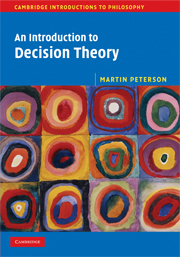Book contents
- Frontmatter
- Contents
- Preface
- 1 Introduction
- 2 The decision matrix
- 3 Decisions under ignorance
- 4 Decisions under risk
- 5 Utility
- 6 The mathematics of probability
- 7 The philosophy of probability
- 8 Why should we accept the preference axioms?
- 9 Causal vs. evidential decision theory
- 10 Bayesian vs. non-Bayesian decision theory
- 11 Game theory I: Basic concepts and zero-sum games
- 12 Game theory II: Nonzero-sum and cooperative games
- 13 Social choice theory
- 14 Overview of descriptive decision theory
- Appendix A Glossary
- Appendix B Proof of the von Neumann–Morgenstern theorem
- Further reading
- Index
Preface
- Frontmatter
- Contents
- Preface
- 1 Introduction
- 2 The decision matrix
- 3 Decisions under ignorance
- 4 Decisions under risk
- 5 Utility
- 6 The mathematics of probability
- 7 The philosophy of probability
- 8 Why should we accept the preference axioms?
- 9 Causal vs. evidential decision theory
- 10 Bayesian vs. non-Bayesian decision theory
- 11 Game theory I: Basic concepts and zero-sum games
- 12 Game theory II: Nonzero-sum and cooperative games
- 13 Social choice theory
- 14 Overview of descriptive decision theory
- Appendix A Glossary
- Appendix B Proof of the von Neumann–Morgenstern theorem
- Further reading
- Index
Summary
This book is an introduction to decision theory. My ambition is to present the subject in a way that is accessible to readers with a background in a wide range of disciplines, such as philosophy, economics, psychology, political science and computer science. That said, I am myself a philosopher, so it is hardly surprising that I have chosen to discuss philosophical and foundational aspects of decision theory in some detail. In my experience, readers interested in specific applications of the subject may find it helpful to start with a thorough discussion of the basic principles before moving on to their chosen field of specialisation.
My ambition is to explain everything in a way that is accessible to everyone, including readers with limited knowledge of mathematics. I therefore do my best to emphasise the intuitive ideas underlying the technical concepts and results before I state them in a more formal vocabulary. This means that some points are made twice, first in a non-technical manner and thereafter in more rigorous ways. I think it is important that students of decision theory learn quite a bit about the technical results of the subject, but most of those results can no doubt be explained much better than what is usually offered in textbooks. I have tried to include only theorems and proofs that are absolutely essential, and I have made an effort to prove the theorems in ways I believe are accessible for beginners.
- Type
- Chapter
- Information
- An Introduction to Decision Theory , pp. ix - xPublisher: Cambridge University PressPrint publication year: 2009

